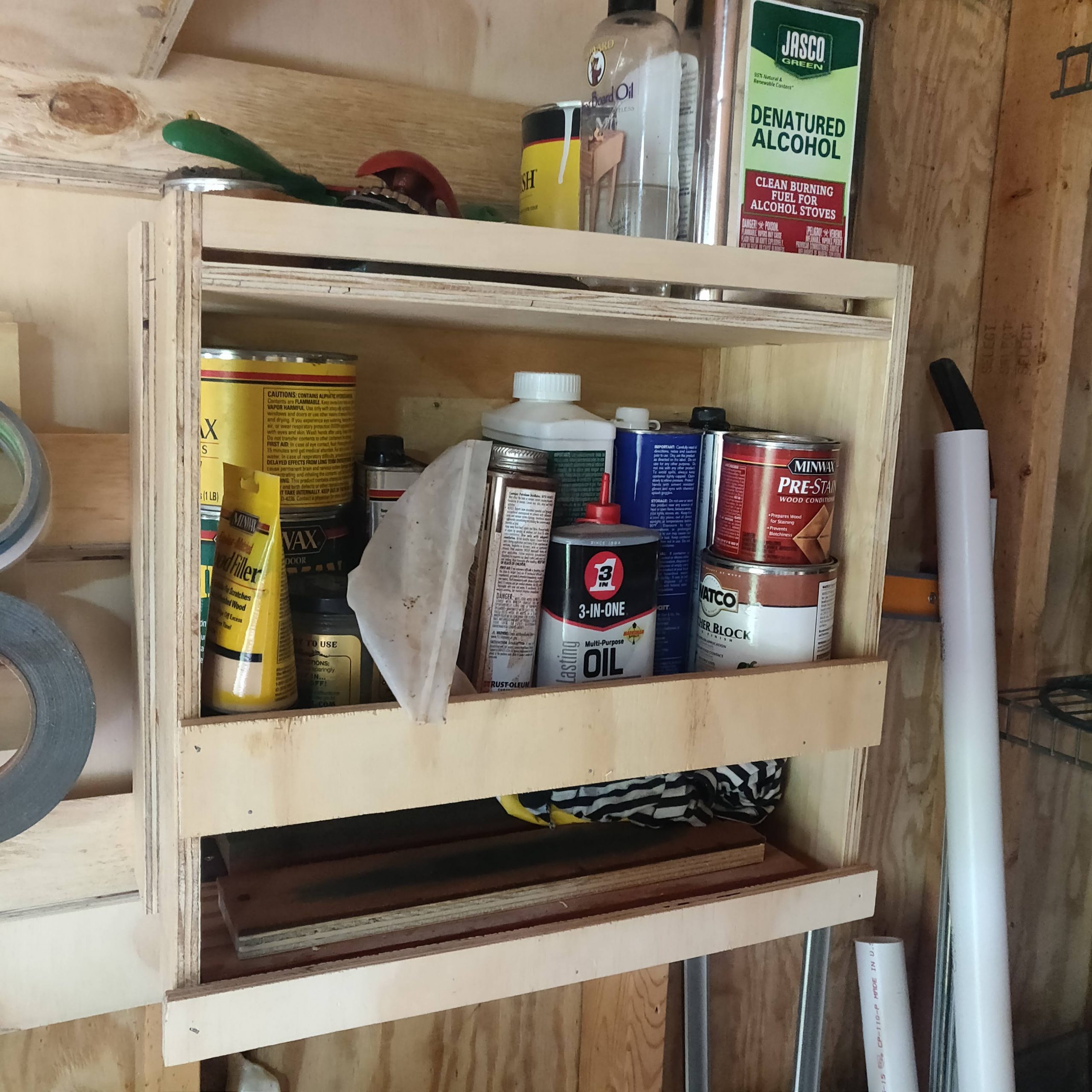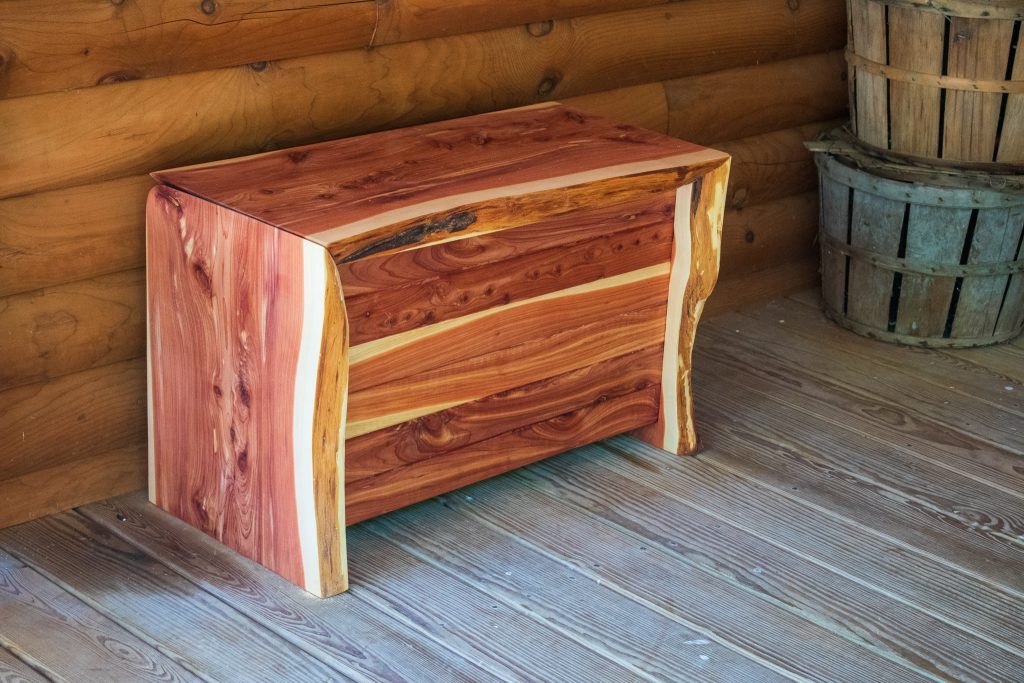This is Part 2 of Built to Last: A Reflection on Environmentally Conscientious Woodworking.
- Built to Last: A Reflection on Environmentally Conscientious Woodworking
- Part 1: I turned my woodshop into a personal solar farm.
- Part 2: Getting a handle on workworking chemicals, or sometimes we all need to vent.
- Part 3: Furniture as Revolution.
- Part 4: The best tool for the job is you
- A good joint is built to last: archaeologists uncover evidence for the earliest structural use of wood.
Walk into any woodshop and you find a shelf full of chemicals. Solvents, paints, varnishes, lacquers, oils, glues, and a host of other exotic and not so exotic solutions are a staple of the craft. These compounds are used to join, clean, prepare, and finish most woodworking projects, as well as maintain your tools. Do any amount of woodworking, and you’ll almost certainly accumulate a shelf of assorted, half-used, chemicals of your own.
What’s almost certainly not present in most woodshops, especially hobbyist woodshops, are the Material Safety Data Sheets (MSDSs) for these chemicals. MSDSs tell you everything you could possibly want to know about the hazards associated with commercial chemical compounds. For many common woodworking products, the MSDSs are pretty intense.
I’ll be completely honest here. I have never had MSDSs in my workshop. It was only while doing the background research for this article that I realized I needed to pay more attention to the assorted chemicals involved in the craft, and started compiling all the potential hazards. I suspect that the vast majority of hobbyist woodworkers are the same.
Woodworking chemicals contain irritants, release volatile organic compounds (VOCs), are cut with heavy metals, and are often just plastic. They can be bad for your skin, bad for your lungs, and bad for your brain. When produced, disposed of, accidentally discharged, or as they break down through regular wear, they can release harmful compounds into the environment. If not disposed of correctly, some of these products will spontaneously burst into flames.
Many fast finishes, the kind that cure in hours rather than days, use cobalt salts as a drying agent to accelerate the curing process. Cobalt salts can be particularly nasty and prolonged exposure can result in neurologic damage. If you can smell boiled linseed oil, you’re inhaling cobalt salts. While consumer-grade woodworking products generally aren’t particularly harmful when handled in small quantities using all proper protective equipment in well-ventilated work spaces, I expect to continue woodworking for the next 40 years. That adds up to an awful lot of voluntary exposure over my lifetime.
It’s not necessarily the usual suspects that are the most concerning. The harshest, most volatile finishes are often so astringent that most woodworkers will instinctively mask up or take their projects outside. But some of the seemingly inoffensive compounds can hide some nasty surprises. Take paste wax for example. Paste wax is a blend of wax and oil used in woodshops everywhere. Peruse woodworking YouTube and you’ll find dozens of videos of professional woodworkers applying paste wax bare-handed and unmasked. And that might be fine, but commercial paste wax has a Hazardous Materials Identification System (HMIS) respiratory health hazard rating of 3 with category 3 single exposure specific organ toxicity, as well as other single and repeat exposure concerns, almost all likely related to the solvents used to help paste wax dry faster and buff smoother.
Does that mean paste wax is bad? Of course not. It just means that the material requires a little more caution than most hobbyist (and even professional) woodworkers usually extend to the ubiquitous furniture polish.
Awareness of materials and their specific potential harms is at the heart of environmentally conscientious woodworking.
Just One Word.
In thinking about how to build a woodworking shop that is grounded in an environmental ethic, there is one specific material which occupies a position of particular focus, both because of its inescapable ubiquity and its long and diverse array of environmental impacts: plastic. Plastic and plastic waste enters the woodshop through many pathways: in packaging, in consumables, and in the products we use.
Avoiding plastic in packaging material is an impossible uphill battle. Nearly every woodworking product comes sealed, in some form, in plastic. Glue bottles are plastic. Saw blades come in plastic blister packs. Plastic parts come in plastic packages. Over the lifetime of a woodworker, the most effective way to reduce the amount of plastic trash produced by packaging is to buy less, buy used, and maintain your tools so that they last longer and don’t need to be replaced. In that, at least, woodworkers are already primed to invest in hardware for the long haul.
Consumables are a separate issue. If we’re focusing not just on impacts to the world around us, but on personal health and safety, then consumables are unavoidable. Disposable gloves, masks, and filters are critical pieces of personal protective equipment (PPE). If you’re working with chemicals that require PPE, PPE is not optional. The obvious solution, then, is to use finishes and other woodworking chemicals that don’t present significant health hazards.
Which brings us to finishes. Many modern finishing products are various flavors of plastic, produced as a byproduct of petroleum extraction, and waiting to be converted into micro-plastic particles and freed into the environment. Almost all finishes that build a film on the surface, with the exception of shellac (which is a resin secreted by lac beetles), are some form of plastic. That doesn’t inherently make them a bad choice for finishing, but plastic does present a unique set of environmental concerns. No finish lasts forever, and any time you sand or strip a layer of polyurethane from a surface, that plastic goes somewhere.
Polyurethane, in particular, is a petrochemical-derived finish that cures into a hard layer of plastic. The MSDS for Minwax Wipe-on Poly, previously my preferred finish when I wanted an easy, hard wearing surface that looks pretty nice, is a laundry list of everything you want to avoid in recreational chemical exposure. Prolonged exposure can cause neurological and respiratory damage and can get you high (never a good thing when power tools are nearby). Beyond the health implications, polyurethane-based finishes aren’t all that great for the environment, either. Sanding between coats creates a fine microplastic dust that will invariably find its way into the ecosystem. Microplastic particles that enter the environment are turning up in everything from fish guts to human organs.
And here’s the dirty secret: every ounce of polyurethane you’ve ever applied or removed from a piece of wood is still out there in the world. Long after your furniture falls to dust, those particles of polyurethane will endure.
Are there any woodworking chemicals that are generally safe? The good news is that probably the most frequently used chemical in any woodshop — trusty old PVA glue — is a relatively friendly option. PVA glue is a thermoplastic that is water soluble, is readily broken down by many microorganisms, has not been found to accumulate in the environment, and doesn’t have any known exposure issues. It’s biodegradable and compostable. Elmer’s Glue is the same stuff and kids have been eating Elmer’s for generations.
PVA is about the safest adhesive you’re going to find. Even hide glue has a slightly higher rating for skin and respiratory irritation. But PVA has one major downside: it is usually a petroleum byproduct. The vast majority of PVA products are produced from ethylene derived from petrochemical refining. It doesn’t have to be, and there are plant-based PVA glues available.
Production is an unavoidable source of concern for an environmentally-minded woodworker, but disposal is the one part of the life cycle of a woodworking product that we have ultimate control over. Unfortunately for the hobbyist, the best chemical waste disposal options may not always be available.
A professional woodshop will have a workflow that is optimized for uniformity, budgets for minimal waste, settles on a few specific products, and has access to bulk chemical disposal services. One consequence of doing smaller projects, each of which often demands a different finish in quantities too small to present a cost-benefit advantage, is the accumulation of half-used and expired chemicals in a variety of containers and conditions.
The most responsible among us will safely store these products until there are enough to justify a trip to a waste handling facility or calling up a chemical disposal service. The least responsible will send them out with the trash. But most of us fall in the middle, and I suspect the vast majority of us will simply store them in some far corner of the basement, forever. This is not a phenomenon unique to woodworking. It’s fairly common among all handy homeowners. In the last ten years, I’ve rented three houses and owned two, and every single one came with a small collection of assorted, expired chemicals left behind by the previous residents.
The point here isn’t to scare you or dictate which finishes you should or shouldn’t be using. With proper protective equipment in a well-ventilated space, all of these chemicals are safe to use. And almost all finishes, once properly cured, are completely inert. Everyone has their own personal safety threshold, and their own tolerance for placing a chemical burden upon their local ecosystem, but you can’t make an informed assessment of the chemical hazards in your workshop if you don’t know what you’re handling.
What steps am I taking to minimize the impact of my craft?
The big targets for me are minimizing chronic low-level exposure to chemicals known to have neurological impacts and eliminating as much plastic from my entire workflow. Those end up being mutually complementary goals. I am shifting away from polyurethane and other plastic-based finishes and processes (sorry folks, there won’t be any big epoxy river tables on my Instagram) and limiting the number of chemicals that require disposable gloves and other plastic barriers. It also means preferentially shopping for new tools and consumables that minimize plastic waste. I’ll pay more attention to which solvents and drying agents are used in assorted finishes and preferentially select those that have the fewest adverse health impacts. Unfortunately, I already have a full chemical bin, and since the best way to dispose of woodworking chemicals is to use them and let them cure, what I do have I will continue to use until they’re exhausted, and then safely dispose of the containers.
I’m in the process of testing out a handful of less harmful finishing products, including Odie’s Oil, which has one of the least concerning material safety data sheets I’ve ever seen. Odie’s can be applied without gloves or respirators, which means that in addition to being a more health-friendly material, it reduces the amount of plastic consumables waste in my workshop. It also looks pretty dang good if you’re a fan of natural wood. For a lighter wood, I’m experimenting with soap finishes, which are literally just soap and water. Neither are remotely as hard wearing as a polyurethane film finish, but there are always trade-offs with any finish and a bit more maintenance is an acceptable compromise for me. And for cases where I need a harder-wearing film finish, shellac is quickly becoming my go to choice.
For outdoor projects, we’re still in a tight spot. Anything that’s going to be left in the elements needs a finish that is tough, flexible, and UV resistant. This is a bit of a catch-22, since the finishes themselves tend to be less environmentally friendly and will wear away more quickly when exposed to weather. Fortunately, outdoor projects have access to the most environmentally friendly finish – no finish at all. Selecting high-quality, rot-resistant wood means I can build outdoor projects that need no finish and will age to a rich silver patina in the sun.
I’m not a huge fan of painting or staining wood, but milk paint, both commercial and hand-mixed, is fairly inoffensive with no particular points of concern in the handful of MSDSs I reviewed.




